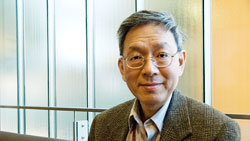Hall computers never sleep

Computer Science professor Clement Lam
rob maguire
If you google "Lam's Problem," you'll get the description of how Clement Lam solved one of the most demanding problems in his field, the search for a finite projective plane of order 10.
The math proof took him and his colleagues two years on powerful computers. It earned them a place in mathematical history, an article in the New York Times, and an entry in the 1989 Encyclopedia Britannica Science Year Book.
His work will be acknowledged with the Euler Medal from his peers around the world in the Institute of Combinatorics and its Applications.
It took more than 800 days on several VAX-11/780 computers at Concordia and 3,000 hours of computing time on a CRAY-1A supercomputer at the Institute for Defense Analyses in Princeton, N.Y. to complete that remarkable search back in the 1980s. As computers become faster and cheaper, researchers are more ambitious.
A year ago, Lam and his team finished off another long-standing mathematical problem that took over 250 years of CPU time at several universities in Canada and the United States.
The initial estimate was that it would require five years to accumulate enough computing time on the available research computers to finish the problem. However, computing efforts at Concordia got a big boost in 2004 when the Academic Information Technology Services (AITS) of the Faculty of Engineering and Computer Science helped to create an environment where Lam could tap into the unused computing powers in the undergraduate teaching laboratories.
Lam was allowed to run programs in the background as long as they didn't interfere with any other users. Whenever the background program sensed some user activities (for example, a mouse movement), the program would suspend itself immediately and get out of the way of the user.
He told the Journal that getting access to the computers in the undergraduate laboratories of the Hall Building was only a start.
These computers supported two versions of the operating system, Linux and Windows, and students could reboot between them at random. Over the course of a day, most of the computers would be rebooted into running Windows.
Lam's computer program had to be run under Linux. Fortunately, as part of the daily maintenance, computers in the undergraduate laboratories were rebooted every morning around 4 a.m. About half of them were chosen at random to be rebooted to Linux.
Lam installed a program that woke up around 4:30 a.m. and looked for Linux machines to run his program. In fact, he woke up regularly around 5:30 a.m. to check the status of his computing. At that time of the day, almost no one would be on the computer systems, and he would typically have 150 computers working on his problem.
By about 8 a.m., as students started coming in, fewer and fewer computers would be available, until by around 10 p.m., he would be lucky to have 30 computers left.
In Lam's estimation, having access to these computers in the undergraduate laboratories probably advanced the completion time of his project by about two years. He would like to thank the staff in AITS, especially Michael Assels and Marco Rigotti, who made it possible.
"The whole experiment [of using the Hall Building computers] went so smoothly that none of the undergraduate students even noticed!" Lam said in admiration.